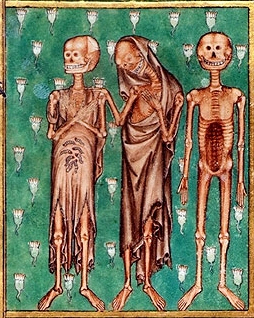The Medieval Revenant

During the middle ages a belief in souls returning from the dead was very common. A revenant was an animated corpse believed to have been revived from the dead to haunt the living. At various times the term revenant has often been used interchangeably with vampire. Numerous contemporary writers of the period recount stories relating to these undead souls.
Perhaps the most well know is William of Newburgh (or Newbury) (lived 1136 – 1198 in England). He recorded that such stories were common “were I to write down all the instances of this kind which I have ascertained to have befallen in our times, the undertaking would be beyond measure laborious and troublesome!” This didn’t however stop him later recounting such stories with some ghoulish satisfaction.
He continues, “It would not be easy to believe that the corpses of the dead should sally (I know not by what agency) from their graves, and should wander about to the terror or destruction of the living, and again return to the tomb, which of its own accord spontaneously opened to receive them, did not frequent examples, occurring in our own times, suffice to establish this fact, to the truth of which there is abundant testimony.”
It seems William was a believer at least as far as he didn’t discount out of hand the stories he came across. To the medieval mind it seems it was a perfectly possible scenario to have the recently departed wandering around the countryside terrifying the living.
One story involves a man who becomes jealous of his wife. Trying to catch her up to no good he hides in the bedroom rafters. Unfortunately, he manages to fall from his hiding place, seriously injuring himself in the process and dies a few days later. This is where things take a sinister turn.
“By the handiwork of Satan, from his grave at night-time, and pursued by a pack of dogs with horrible barkings, he wandered through the courts and around the houses while all men made fast their doors, and did not dare to go abroad on any errand whatever from the beginning of the night until the sunrise, for fear of meeting and being beaten black and blue by this vagrant monster.”
The monster then goes on a rampage and kills several of the townsfolk before they take action to counter the horror.
“Thereupon snatching up a spade of but indifferent sharpness of edge, and hastening to the cemetery, they began to dig; and whilst they were thinking that they would have to dig to a greater depth, they suddenly, before much of the earth had been removed, laid bare the corpse, swollen to an enormous corpulence, with its countenance beyond measure turgid and suffused with blood; while the napkin in which it had been wrapped appeared nearly torn to pieces. The young men, however, spurred on by wrath, feared not, and inflicted a wound upon the senseless carcass, out of which incontinently flowed such a stream of blood, that it might have been taken for a leech filled with the blood of many persons. Then, dragging it beyond the village, they speedily constructed a funeral pile; and upon one of them saying that the pestilential body would not burn unless its heart were torn out, the other laid open its side by repeated blows of the blunted spade, and, thrusting in his hand, dragged out the accursed heart. This being torn piecemeal, and the body now consigned to the flames.”
A tale which surely wouldn’t disgrace a modern horror film.
In the 12th Century the chronicler Walter Map records a similar tale of a “wicked man” of Herefordshire who comes back from the dead. He takes great pleasure in wondering the streets of his village during the night-time calling out the names of those who will die of a sickness. Naturally his fellow villagers are less than impressed. They enlist the help of the bishop of Hereford who authorises them to dig up the body and cut of its head with a spade. He sprinkles it with holy water and re-inters it in the hopes it will desist its nightly rambles.